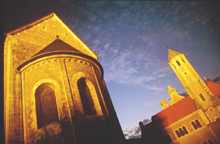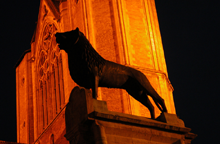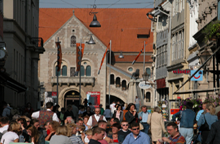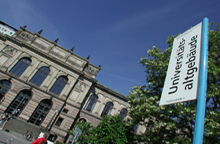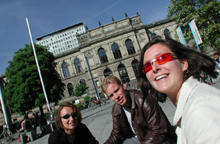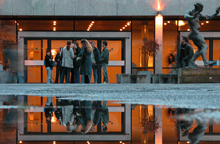|
GAME-ON®'2006
November 29th - December 1st, 2006
Technical University of Braunschweig, Braunschweig, Germany
VenueThe city of BraunschweigBeing an important cultural and political centre since the middle ages, Braunschweig retains impressions of each passing age, from the medieval castle and the gothic cathedral to modern shopping streets and leisure facilities. The City of Braunschweig's history dates back to the 10th century, when it was a market settlement and a crossroad for major foreign trade routes. Henry the Lion chose to make it his residence in the early Middle Ages and Braunschweig subsequently developed into a large and influential medieval city. Braunschweig's historic city image has survived in its unregular and narrow downtown street layout and in many of its magnificent architectural monuments. The city's landmark, the Lion Monument, is still a symbol of the strength and political power of those times. Today, the city of Henry the Lion is a lively modern town and the second largest city in Niedersachsen. With a population of 250,000 it is big enough to feel cosmopolitan and still small enough not to be overwhelming. Braunschweig is a "green" city with numerous parks and open spaces. The surrounding countryside provides lots of opportunities for heading out of the city and retreating to places of natural beauty and historical interest. Braunschweig's cultural life is rich and varied. The Staatstheater and the Braunschweiger Staatsorchester offer drama, dance, music and opera. A great number of festivals and cultural events throughout the year attract well-known names in drama, film, show, classical and rock music. For more information visit: http://www.braunschweig.deCity of ResearchAs one of Germany's most active regions for research and development Braunschweig has a large number of leading national research institutes. These institutes of international repute represent an enormous scientific potential and provide strong links between industry, science and research. The high density of research facilities and industry in the Braunschweig region encourages interdisciplinary networking and technology transfer. Students and scientists benefit greatly from the partnerships between university departments, research institutes and industry and the unique atmosphere for scientific work they meet at the Technische Universität Braunschweig. The TU Braunschweig works in partnership with two other institutes of higher education, the Braunschweig School of Arts (HBK) and the Braunschweig/Wolfenbüttel University of Applied Sciences, and there are cooperation agreements with the following local research institutes: Federal Research Centre of Physics and Metrology (PTB) Technische Universitšt BraunschweigFounded in 1745, the Technische Universität Carolo-Wilhelmina zu Braunschweig is Germany's oldest technical university and looks back on a two and a half century tradition of academic teaching and research. When the University admitted its first students in the middle of the 18th century, the curriculum encompassed most of the classical academic disciplines as well as technical subjects. In the course of industrialization the technical disciplines gained more importance and in 1862 the former Collegium Carolinum became a Technical University. The University's name commemorates the Dukes Carl and Wilhelm of Braunschweig-Lüneburg, under whose patronage the Carolo-Wilhelmina developed into one of the country's leading teaching and research universities. Today the TU Braunschweig is the centre of one of the most active German research regions. The university has more than 14,000 students and employs 2,600 staff members, 1,600 of whom are scientists and researchers. It is organized in 10 departments and 111 institutes, offering a wide range of courses and research opportunities. In addition, a great deal of teaching and research takes place in interdisciplinary programmes, laboratories, and centres whose work extends beyond traditional departmental boundaries. Quality assessment reports confirm that the University's curriculum and teaching maintain the highest standards, with Braunschweig being at the forefront of innovation in research and methods of teaching and learning in many subjects. The diversity of the academic curriculum, the broad range of research activities and the great number of national and international partnerships all contribute to a vibrant academic community where students and staff work together in an interdisciplinary teaching and research environment. For more information visit: http://www.tu-braunschweig.de © TU Braunschweig, Public relations department. All featured pictures are property of Okerlandarchiv. How to reach BraunschweigBy plane and trainFrom Hannover Airport (HAJ) you have to pick train line S5 to Hannover Hauptbahnhof. At Hannover Hauptbahnhof there are several trains to Braunschweig. From Frankfurt Airport (FRA) you have to change train at Frankfurt main station. There is a hourly direct train connection to Braunschweig. From Berlin Tegel Airport (TXL) use either JetExpressBus TXL or the X9 or 109 bus line to get into Berlin. From the Zoo-Station (Zoologischer Garten) several trains go to Braunschweig. From Berlin Schönefeld Airport (SXF) take the Train S9 to the Zoo-Station (Zoologischer Garten). There you'll find several train connections to Braunschweig. From Hamburg Airport (HAM) you can take a bus directly to the Hamburg Hauptbahnhof. This is where you can take a train to Hannover Hauptbahnhof. At Hannover Hauptbahnhof there are several trains to Braunschweig. By carTo find the best route please use a route planner like http://www.viamichelin.com. Parking space at the university is very limited during the semester. However, there is a parking space for university members at the end of the Katharinenstrasse, 38106 Braunschweig. From there it's only a minute by foot following the tram towards the city center. The glass building you see to left is the computer science center. Please have a look at the pages of the Institute of Operating Systems and Computer Networks. There you can see the parking space (next to the "Mensa") and the entrace of the CS center. The conference rooms are on the first floor.How to reach the conference site by public transportPlease have a look at the pages of the Institute of Operating Systems and Computer Networks. The conference rooms are on the first floor. | ||
© Copyright ETI Bvba - EUROSIS - All Rights Reserved. GameOn® is a registered trademark of ETI Bvba (Nr.: 1061384-761314) | |||

